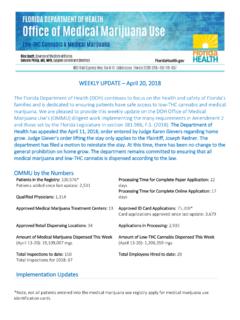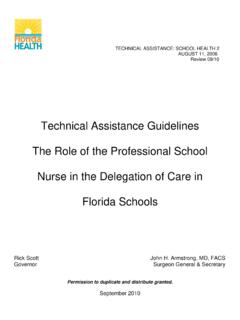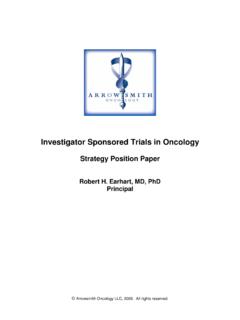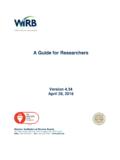Transcription of Principal Investigator: Ivan Gonzalez, MD, Assistant ...
1 1 Principal Investigator: Ivan Gonzalez, MD, Assistant Professor of Clinical Pediatrics Organization: University of Miami Presentation Title: An Integrated Team Science Approach for Comprehensive Evaluation for Zika in Utero Infection Research Priority Area: Health Effects of Zika Virus Abstract: The geographical location of Miami makes it the epicenter of Zika-related infections and in 2016 Florida experienced an epidemic proportion of Zika related travel and non-travel related infections. Pregnant women are particularly vulnerable to Zika virus infection due to the association of Congenital Zika Syndrome and microcephaly. About 5% of babies born to Zika infected mothers in the US have been diagnosed with serious birth defects which ranges from abnormal brain development, neurodevelopmental, seizures, visions and hearing problems amongst others.
2 Many aspects of the Zika exposure in utero remains unknown, specifically the risk for adverse outcomes beyond microcephaly and long-term sequela due to congenital Zika infection. Thus, the primary goal of our research is to build a comprehensive blueprint to define and evaluate how Zika virus exposure in utero cause collateral damage to both infected and exposed children. Our study population consists of dyad (mother and child pair) and we will follow both Zika infected and exposed babies through an integrated team science approach from birth to 36 months. This was purposely developed to facilitate a unified enrollment process and allow a joint recruitment amongst all four Pediatric proposals. Significant steps to build a clinical care model under one umbrella comprising of several disciplines was undertaken and a Pediatric Zika Research Initiative Team was formed to follow the same dyad for all four protocols.
3 Our recruitment strategy has been divided into two categories prospective dyads (pre- and post-natal) and retrospective (infants 3-12 months after birth). We are conducting comprehensive laboratory, end organ (renal, cardiovascular and neurology), brain scans, neurodevelopmental, ocular, hearing and swallow assessments. Furthermore, we have assembled clinical coordinators and data management teams who will assist in meeting regulatory benchmarks and generating high quality data for statistical analyses. Our team has submitted a case report the first locally-acquired congenital Zika syndrome case in the United States presenting with different ocular findings associated with Congenital Zika Syndrome. Seven prospective dyads have enrolled and have completed portions of the longitudinal study.
4 Our team is also in the process of enrolling retrospective infants. The full spectrum of outcomes of in utero Zika infection is unknown and therefore a comprehensive model of care and management developed through our Pediatric Zika Research Initiative team at our institution is unique. The potential impact and significance of our research is the early identification of children at risk very early in their life whereby new measure and point of care can be implemented to help facilitate early intervention and thus reduce any associated morbidity or mortality. In addition, data generated will inform the public health systems to facilitate clinical guidance to health care providers. 2 Principal Investigator: Eric Holmes, PhD, Assistant Vice President for Research Organization: Florida State University Presentation Title: Human Pharmacokinetics of Niclosamide Research Priority Area: Health Effects of Zika Virus Abstract: Presently there are no drug treatments for Zika virus infections.
5 However, recent published reports have demonstrated that the drug niclosamide inhibits Zika virus replication in the sub-micro molar range. Niclosamide is currently approved by FDA for the treatment of tape worm infections in the gut and has an established wide safety margin. The marketed drug, Niclocide (also marketed as Yomesan, Bayer Pharmaceuticals), is an oral chewable tablet. The adult dose is 2 grams of niclosamide per day (either as a one-time dose or daily for a week), or a dose of about 25- to 33 mg/Kg body weight per dose. Studies in rats demonstrated that a 5 mg/Kg niclosamide dose yielded a blood level of micromolar. Thus, despite the poor oral bioavailability of niclosamide (about 10%), it is possible that the approved 2 gram/day dose would be adequate to achieve a blood level in humans in the 3- to 10 micromolar range.
6 Should this level be achieved, it would be several multiples of the concentration recently shown to inhibit Zika replication in vitro. Given the significant public health threat posed by Zika virus infections, especially in pregnant women, the availability of an easily adapted marketed drug for Zika therapeutics represents a major opportunity. In particular, use of an off-the-shelf therapeutic could make a rapid and critical impact and buy important time while a more efficient niclosamide formulation could be developed. The first step is to determine the human pharmacokinetics profile of the marketed formulation Niclocide through a small human clinical trial involving 12 to 15 normal volunteers. A fed/fasted cross-over study is currently being designed and regulatory approval sought for a trial to determine niclosamide blood levels over a 3-day dosing period to capture both initial uptake as well as steady state blood levels.
7 It is anticipated that this trial will be completed in 1Q2018. This data will provide support for a subsequent case-control study with Zika infected individuals. These results will provide critical evidence related to a potential treatment for Zika virus using an existing yet repurposed drug. Such a rapidly developed treatment will pay huge dividends in the control and impact of Zika virus in humans. 3 Principal Investigator: Claudia Martinez, MD, FSCAI, Associate Professor Organization: University of Miami Co-Presenters: Tahir Haque, MD, Resident Physician Presentation Title: Cardiovascular Complications Related to Zika Virus Infection: The Zika Heart Study Research Priority Area: Health Effects of Zika Virus Abstract: The World Health Organization declared the 2016 Zika outbreak a Global Public Health Emergency and Florida one of the most affected areas within the United States.
8 Previous reports documented the association of flavivirus infections such as Dengue, Chikungunya and West Nile, with the presence of an inflammatory disease of the heart and vessels after 6 months of viral infection. Complications have included depressed cardiac function as well as peri- and myo-carditis that may develop following infection and progress long-term. Because Zika virus is one of the flaviviruses that manifests with systemic infection, there is a risk for cardiovascular involvement either by direct organ damage or indirectly through a secondary inflammatory response. Therefore, Zika infection-related anomalies may be present in both cardiac structure and function as well as in the vasculature. However, the presence of cardiovascular complications in Zika-infection has not been previously examined.
9 We will examine whether Zika-seropositive compared with Zika-seronegative adult men and women will manifest cardiovascular complications within 6 months following infection diagnosis and over 1 year following study entry. The University of Miami has established a Zika Global Network assembled with clinical and basic researchers, which includes an Infectious Disease team dedicated to evaluating and managing the health care of all potential Zika-infected patients. Participants will be recruited via this network primarily. The 3-year study will include 30 adult participants (18-50 years of age), who will be enrolled within 6 months of Zika virus testing. Those persons testing positive will be compared with those testing negative by assessment at enrollment and one year later.
10 The comprehensive cardiovascular evaluation at these time points will include cardiac MRI, echocardiography, 12-lead ECG, and vascular endothelial function assessments. In March 2017, at the annual American College of Cardiology meeting, the results of a small case series (n=9) suggested the actual presence of cardiovascular complications in Zika-infected patients from South America including 89% arrhythmias and 67% heart failure. In our study, of the 30 participants, 4 have been enrolled. Zika infection usually presents with mild and non-specific symptoms; therefore, detection of cardiovascular complications may go undiagnosed. Results of this study will improve understanding of the Zika-related cardiovascular morbidities in the first year following infection. Detection of greater cardiovascular system involvement in Zika infection would support the modification of clinical evaluation to include cardiovascular screening in these patients.















